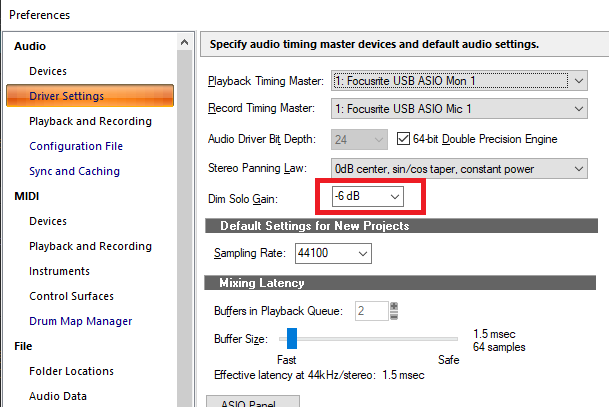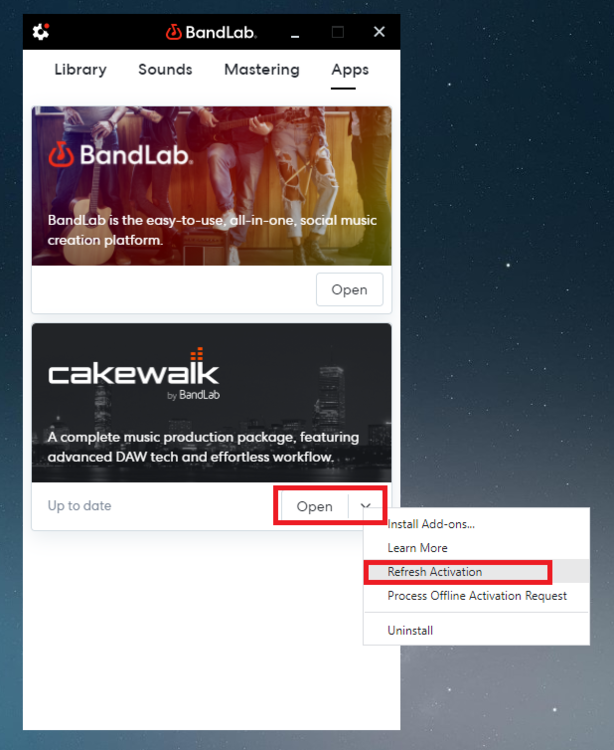-
Posts
6,935 -
Joined
-
Last visited
-
Days Won
36
Everything posted by msmcleod
-
This is certainly not new to 2021.12. I can get it in SONAR X2, SONAR X3, SONAR Platinum and CbB: 1. Open the PRV 2. Make the main window floating 3. Undock the PRV 4. Lock the PRV View 5. Set PRV to "Disable Floating" 6. Make the PRV full size. Here it is in X2:
-
No, it's the locked view indicator - see : http://www.cakewalk.com/Documentation?product=Cakewalk&language=3&help=WindowManagement.05.html Locked views are particularly useful for things like the PRV, as it means you can have multiple PRV's open with each one locked to a particular track.
-
This is because the images are stored on a non-secure server, whereas the rest of the site is being served up from a secure server. Either: 1. Change the start of the website address to http:// instead of https:// or 2. Set your browser to allow mixed content for cakewalk.com
-
You can assign a keyboard shortcut to CAL scripts within Preferences -> Keyboard Shortcuts
-
Export presets don't save the file location because they are global presets of the export settings - in other words they store the source type and format settings, but not any project specific information like specific tracks/buses and location. The Export Tasks however, do store all of this information. So the way to do it is to create an export task in each of your album's projects set to your album location.
-

How can I put an audio in reverse on Cakewalk?
msmcleod replied to Scott Pismire's topic in Instruments & Effects
1. Select the Clip 2. Process -> Apply Effect -> Reverse -

Audacity features that Cakewalk is missing.
msmcleod replied to John Bowles's topic in Feedback Loop
This is my go to method for moving stuff along, especially with larger or more complex projects. Comparitively speaking, from a code point of view, the implementation is very simple and therfore much quicker than moving sections or using ripple edit. -
What's your dim solo level set to? The lowest level is -18db, which might be too quiet to hear depending on the project. You can change the level in Preferences- > Audio -> Driver Settings -> Dim Solo Gain:
-
Yes to both questions. 2021.12 Build 91 and above will try to divide the 5 button image into 8, and end up showing a garbage image.
-
That I'm not sure about, as its a change to an existing image - no new image resources have been added.
-

Top 2 Most Wanted Missing Features of CBB
msmcleod replied to Mark Morgon-Shaw's topic in Feedback Loop
Aha - forgot about that one - cheers @scook ! -

Top 2 Most Wanted Missing Features of CBB
msmcleod replied to Mark Morgon-Shaw's topic in Feedback Loop
The only advantage I can see with VCA faders vs CbB grouping is that with VCA faders, you can adjust the other tracks independently from the VCA fader. In CbB to do this, you need to first remove the fader from the group, make the adjustment, then add it back. E.g.: Yes, this can be a pain, but I normally get around this by grouping the automation R/W buttons too. This way I don't forget! -
My old location recording rig was running on an old laptop with a 1280 x 1024 screen. I used a combination of @Colin Nicholls suggestion and screensets, e.g: ScreenSet 1: No browser, No track inspector, track view fully maximised ScreenSet 2: No browser, Half width track inspector, console fully maximized with narrow strips ScreenSet 3: No browser, Half width track inspector, track view fully maximized For screensets 1 & 3, I used custom control manager settings to minimise widgets available.
-
Just a heads up... any custom themes will need the Archive button updated to work with CbB 2021.12 EA (build 91 / 93). It's now a tri-state button similar to the mute button (i.e. 8 images), in order for folders to indicate that some of the tracks are archived. Old Button: New Button:
-
MixCraft is a great little DAW, and really easy to use. It's particularly good when working with video.
-
If you've installed anything recently, your redists could have been messed up. You can install the latest redists by following the instructions here: If this doesn't work, try launching Cakewalk with SHIFT held down. This should reset your configuration. Next think to try is uninstalling/re-installing Cakewalk. You can use the web installer for re-installation: If it's still not starting, it could be your Cakewalk registry settings are corrupt. In this case: - Uninstall Cakewalk - In RegEdit delete the following key: Computer\HKEY_CURRENT_USER\SOFTWARE\Cakewalk Music Software\Cakewalk\Core Note: Do NOT delete the "Computer\HKEY_CURRENT_USER\SOFTWARE\Cakewalk Music Software\Cakewalk\Cakewalk VST X64" key - this will save you having to re-scan your plugins. - Re-install Cakewalk using the web installer above.
-

the horror of going back to Windows from a Mac mini
msmcleod replied to Marc Harris's topic in Cakewalk by BandLab
The only way to aggregate ASIO devices from different manufacturers that I've found is to use ASIO Link. ASIOLink works in a similar way to ASIO4ALL, but instead of only using WDM, it also allows passthru to an ASIO device. It also remembers your configuration. You set up ASIOLink to connect to your devices, then use the ASIOLInk ASIO driver within Cakewalk instead of your regular ASIO driver. You can do it in two ways: 1. Run a single instance of ASIOLink using ASIO for your main driver, and WDM for the others. 2. Run several instances of ASIOLink using ASIO on each device, connected together via the network using your local network address (127.0.0.1). Once it's set up it works really well, but it's a total PITA to configure in the first place. Even with decades of experience in audio / network experience it took me ages to get my head around it... and no, I don't remember how I did it, so don't ask me ? ! In the end it was too much hassle for me, so I just bought an RME Digiface USB instead. Feel free to check it out tho: -

Bandlab site down - no updating an my reg runs out in 2 days
msmcleod replied to Alan Tubbs's topic in Cakewalk by BandLab
@Alan Tubbs - on Windows 7 you can always download and install the latest version of BandLab assistant, got to the Apps tab, then select Refresh Activation from the Cakewalk Open menu: If you're still getting issues, then it's likely your Windows 7 security settings are out of date. You can solve this by going here: https://support.microsoft.com/en-us/topic/update-to-enable-tls-1-1-and-tls-1-2-as-default-secure-protocols-in-winhttp-in-windows-c4bd73d2-31d7-761e-0178-11268bb10392 Search for the "Easy fix" link on that page and install it. You may find that after applying this, activation may start to work from within Cakewalk itself. -

Adusting faders on group with Icon Qcon Pro G2
msmcleod replied to Anders Madsen's topic in Cakewalk by BandLab
Quick grouping doesn't work with control surfaces, only when using the UI. You'll need to use standard grouping for this: -
Maybe Windows has blocked the DLL ? You can unblock it by: 1. Go to C:\Program Files\Cakewalk\Shared Surfaces in Windows Explorer 2. Right click on MackieControl-MMcL-1.dll and select Properties from the context menu 3. Check the unblock checkbox, click Apply, then click OK. 4. Do the same for MackieControl-MMcL-2.dll and MackieControl-MMcL-3.dll.
-

How To Setup A Peavey Studiomix In Cakewalk By Bandlab?
msmcleod replied to albert williams's question in Q&A
First ensure that the StudioMix is connected to its own dedicated MIDI interface - you can't daisy chain it with other controllers/keyboards. Ensure the MIDI out of the StudioMix is connected to the MIDI input of the interface, and the MIDI input of the StudioMix is connected to the MIDI output of the interface. Press P to bring up preferences Go to MIDI->Devices and ensure the MIDI ports StudioMix is connected to are checked Go to MIDI->Control Surfaces and click the yellow add button in the top right On the Controller/Surface Settings dialog, pick "StudioMix" from the Controller/Surface dropdown (you should see it directly under VS700 ) and set the Input / Output ports to the StudioMix's MIDI ports. Click OK on the Controller/Surfaces dialog Click OK to close preferences -
For question 1: It's unclear whether you mean showing multiple tracks ( i.e. one per track ), multiple staffs for a single track, or you mean a single track but set to wrap around. To pick multiple tracks, select "Pick Tracks" from the staff view "Tracks" menu. To set the number of staffs, select "Layout" on the staff view "Edit" menu, and pick "Treble/Bass" for both the treble & bass staffs (e.g. for piano ) If you meant for the single track to wrap around, Cakewalk doesn't support this for editing / playback. It does however support this when printing. You can use the print preview to get a static view of how it will look when printed.
-
This is correct if you want to quantise to a whole bar in 3/4. If however you actually want whole beats, then set it to 1/4.
-
That looks like the locked view icon, but how it got on the main project window I've no idea. Are you using a custom theme? Perhaps the theme is out of date or corrupt? [Edit] - as the OP has pointed out, it's actually the PRV in the screen shot, which is set to be a locked view.
-
It was changed due to a bug in Windows menus limiting the number of menu items, meaning that not all scanned plugins would be available on the menu (it would only show around 1200 and ignore the rest). It not only affected the menus, it also affected the browser.








